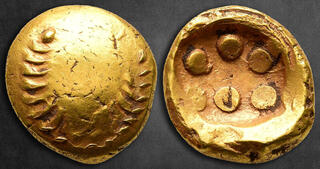| Savoca Numismatik GmbH & Co. KG > Online Auction 203 | Silver | Auction date: 24 March 2024 |
| Lot number: 1 Price realized: 2,000 EUR (Approx. 2,172 USD) Note: Prices do not include buyer's fees. | Show similar lots on CoinArchives Find similar lots in upcoming auctions on |
| Lot description: Central Europe. Germania. The Vindelici circa 150-50 BC. Stater AV 17 mm, 7,51 g Wreath formed of two branches with eight leaves going in opposite directions and with a disc at each end / Six pellets within torque with pellet at each end; all within cup-shaped incuse. The Celtic gold stater, known as the "Empty Leaf Type," is a remarkable issue from the ancient world, shedding light on the artistic and cultural practices of the Celtic people. Dating back to the late 2nd to the early 1st century BC, these staters are a testament to the intricate craftsmanship and symbolic significance in Celtic coinage. Originating from the region inhabited by the Vindelici tribe in what is now southern Germany, these gold staters display a unique design. The obverse features a distinctive leaf wreath made of opposing leaves, adorned with small balls at the ends. Intriguingly, the top of the wreath has only four leaves, a detail that may hold symbolic meaning. The center of the wreath is marked by a dot, surrounded by three small triangles, adding to the mystical allure of the design. The reverse of the coin features a torques, a traditional Celtic neck ring, embellished with six balls. This element not only showcases the Celts' renowned metalworking skills but also reflects their cultural identity, as torques were significant status symbols in Celtic society. The "Empty Leaf Type" gold stater is not just a piece of ancient currency; it is an embodiment of the artistic expression and cultural richness of the Celtic civilization. Its rarity and distinctive design make it a valued piece for historians and numismatists alike, offering a glimpse into the mysterious world of the ancient Celts Beautiful Reddish tone, well centred, Near Extremely Fine Flesche 312; Kellner, Manching, type IV Aa; LT 9423; SLM 1081; Cf. Gorny & Mosch Giessener Münzhandlung, Auction 228, lot 2; Cf. Leu Numismatik AG, Auction 2, lot 16. Extremely Rare! Only one dozen recorded in the past 3 decades and only very few in good condition. In colloquial language, "Regenbogenschüsselchen" refers to a unique type of Celtic gold and silver coin that was in circulation in a region stretching from what is now Hungary through Austria to southern Germany between roughly 200 BC and the turn of the era. These coins are known for their characteristic bowl-like shape and typically lack any inscriptions. Instead, they feature abstract, symbolic patterns or tangible motifs from Celtic iconography. The name "Regenbogenschüsselchen," which translates to "rainbow bowls," derives from a superstition that these gold pieces fell from the sky as if from a rainbow and landed on the earth. The unique curvature of these coins made them stand out when discovered, especially when the sun was at the observer's back, as their shape allowed them to reflect sunlight back in the direction it came from. This sometimes led people to believe that the coin had fallen from the heavens and was gleaming under a rainbow. These mysterious coins were often uncovered during plowing and were believed to bring luck, possessing even healing properties. This finding context likely inspired the Grimm fairy tale "The Star Money." The Bohemian numismatist Nikolaus Adaukt Voigt used the Podmokl coin hoard discovery in 1771 to characterize these coins as early indigenous pieces, dispelling theories about their foreign origin Starting price: 2000 EUR |  |


